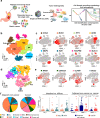Single-cell analysis of gastric pre-cancerous and cancer lesions reveals cell lineage diversity and intratumoral heterogeneity
- PMID: 35087207
- PMCID: PMC8795238
- DOI: 10.1038/s41698-022-00251-1
Single-cell analysis of gastric pre-cancerous and cancer lesions reveals cell lineage diversity and intratumoral heterogeneity
Abstract
Single-cell transcriptomic profiles analysis has proposed new insights for understanding the behavior of human gastric cancer (GC). GC offers a unique model of intratumoral heterogeneity. However, the specific classes of cells involved in carcinogenetic passage, and the tumor microenvironment of stromal cells was poorly understood. We characterized the heterogeneous cell population of precancerous lesions and gastric cancer at the single-cell resolution by RNA sequencing. We identified 10 gastric cell subtypes and showed the intestinal and diffuse-type cancer were characterized by different cell population. We found that the intestinal and diffuse-type cancer cells have the differential metaplastic cell lineages: intestinal-type cancer cells differentiated along the intestinal metaplasia lineage while diffuse-type cancer cells resemble de novo pathway. We observed an enriched CCND1 mutation in premalignant disease state and discovered cancer-associated fibroblast cells harboring pro-stemness properties. In particular, tumor cells could be categorized into previously proposed molecular subtypes and harbored specific subtype of malignant cell with high expression level of epithelial-myofibroblast transition which was correlated with poor clinical prognosis. In addition to intratumoral heterogeneity, the analysis revealed different cellular lineages were responsible for potential carcinogenetic pathways. Single-cell transcriptomes analysis of gastric pre-cancerous lesions and cancer may provide insights for understanding GC cell behavior, suggesting potential targets for the diagnosis and treatment of GC.
© 2022. The Author(s).
Conflict of interest statement
The authors declare no competing interests.
Figures





References
-
- Correa P. Gastric cancer: two epidemics? Dig. Dis. Sci. 2011;56:1585–1586. - PubMed
-
- Ferlay J, et al. Cancer incidence and mortality worldwide: sources, methods and major patterns in GLOBOCAN 2012. Int. J. Cancer. 2015;136:E359–E386. - PubMed
-
- Uemura N, et al. Helicobacter pylori infection and the development of gastric cancer. N. Engl. J. Med. 2001;345:784–789. - PubMed
Grants and funding
LinkOut - more resources
Full Text Sources
Molecular Biology Databases
Research Materials
Miscellaneous

